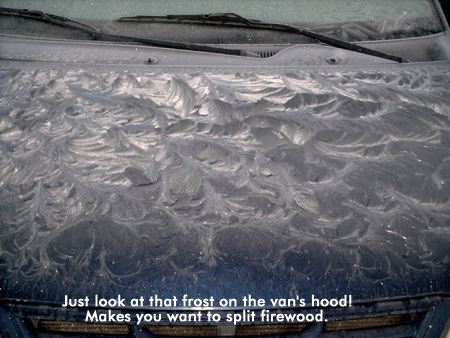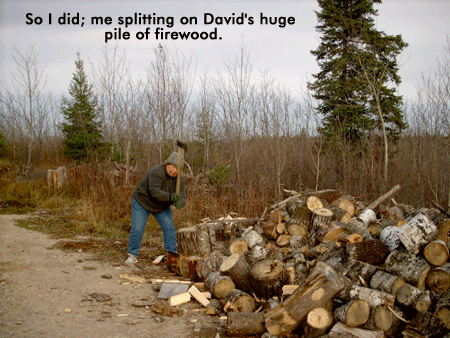There was so much frost on the vehicles this morning when David left for school that he came in and grabbed the digital camera to take a picture. It was in the teens and felt very frosty indeed. We’ve been keeping a fire in our wood kitchen range nearly every day for about a month now, but when we saw that thick frost, we knew it was time to get busy and split wood in earnest.

David had hauled about 5 cords of leftover slash from logging operations nearby this spring. And he brought about 3 more truckloads of firewood from his karate instructor’s house, where he helped saw up down and dead trees. In addition, all summer, we’ve been adding to the pile as we cleared pieces on our land, cut downed trees on the mile long trail to our place and found a tree on the fence. It all adds up and there’s a nice big pile of wood out there. Unfortunately, most of it needs splitting to be useable in the stove.
We are buying a tractor mount wood splitter from my oldest son, Bill, but both the tractor (needing repairs) and the splitter are three hours south of us.

So we’re doing it the old fashioned way for now. With an axe. We’ve got a splitting maul, which we do use. But the axe splits quicker with less backache. I can’t do marathon splitting anymore. I split a few rounds, gather them up and take them into the house, rest, then go do it again until the wood box is full. Or the trailer is full to take around the house to the porch. I’ve learned to pace myself. It takes longer, but it gets done just the same.
Of course things speed up when David can spend time home. That young man can split a truck load in the time it takes me to split a couple of trailer loads of wood. But being a young man, he’s got plenty that takes him away from the homestead; school, sports, youth group, fun with friends, etc.
So I just keep pecking away at that huge pile, which doesn’t seem to get any smaller. (Is it having babies????) Pretty soon, the tractor and wood splitter will be coming home and we’ll go at it warp speed. But for now, it’s just a middle aged woman whacking away at that firewood with an axe. Hey, it works!
Readers’ questions:
Canning ground meat
Hi, Jackie!
You may have mentioned it in the past (I’ve only been a subscriber for less than a year) but I wanted to know how to can Ground Meat. Particularly beef, but also venison, wild hog, goat, etc. I use it a lot with a large family, and don’t like it that I rely solely on the freezer for my supply. I’d like to have it canned and on my shelf for when the electricity goes off. (Happens here a good bit.)Also – does it taste any different from freshly browned ground meat? Should I go ahead and season it? That is, I could put Italian seasoning/onions/garlic on some and Taco seasoning/onions on some, etc. if it works better to be seasoned first. We’re basically at sea level here, so any pressure canning directions would need to be for that.
Many thanks,
Sarah Axsom
Natchitoches, LA
Ground meat is very easy to can and is very handy in a whole lot of recipes. I have a whole lot of ground meat and stewing meat on my pantry shelves to use in recipes throughout the year. All you do is brown the meat and pack it hot into hot jars to within an inch of the top of the jars. You can season it, but don’t use too much and don’t use sage as it gets bitter when canned. You can always use more later on, to spice it up to your taste if it needs more when you use it.
Ground meat is processed at 10 pounds pressure for 75 minutes for pints and half pints, which is probably the amount you’d use in most recipes. Be sure to wipe any grease off the rims of the jars before you put the lids in place; grease can prevent lids from sealing.
I use canned (and seasoned) ground meat as taco filling, sloppy joe mix, with mushrooms and also in mixed recipes, such as chili, spaghetti sauce etc. The taste in recipes is about the same as when you use it fresh. But when heated “plain” it has a texture more like meatloaf, so hamburger patties aren’t so hot. I DO make a lot of different meatballs and these are really handy. Just make the meatballs small enough to be handy in the jars, mix them the way you like and then gently fry them till they’re lightly browned. I’ve canned them with my own Italian tomato sauce and with a mix of cream of mushroom soup and a little water in the pan juice. Both are excellent.
You are wise to begin canning up some ground meat. Not only is it good for just about eternity, but power outages and other emergencies don’t affect the quality or availability of the food. This I like! Besides, it’s just so handy. — Jackie
Making laundry soap
i want to make my own laundry detergent- all things i have found calls for fel’s nappa soap- i make my own bathing soap- would this be the same?- or is there a recipe that you would have for fel’s nappa soap that i could make?-if you could just tell me what fel’s nappa soap is and why it is need to be used- thank you so much- i love the magazine and your column- thank you
sharon woodmancy
marshall, il
To make laundry soap (NOT detergent, much better!!), just make a batch of good old lye soap. Yes, I know lye is a little hard to get right now because some morons are using it in making meth. Yish!! But you can still find it if you look; try Lehman’s Hardware.
I just use an old cheese grater and grate a bar of soap into a bowl. Then I pour boiling water over it and let it sit for about an hour. It’s then good to go. When I didn’t have running water and heated my wash water on the kitchen range, it was nearly boiling when I put it into the wringer washer. Then you could skip the soaking in boiling water step; it would dissolve very nicely in the first load of nearly-boiling water, which made the whites very white without bleach.
When you make a regular batch of lye soap, you’ll get enough bars to do many, many loads of laundry; more if you use a wringer washer as you don’t throw away barely used laundry soap. It has more life than doing just a load of undies and towels!!! One small bar will wash the former, as well as your shirts, bedding and jeans. And you’ll save water too! — Jackie


